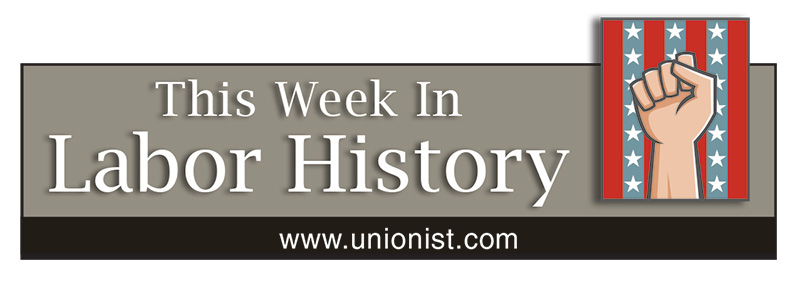This week in labor history: April 26-May 2

APRIL 26
1944 – After management at Montgomery Ward repeatedly refuses to comply with an order by the National War Labor Board (created to avert strikes in critical war-support industries) to recognize the workers’ union and abide by the collective bargaining agreement that the board worked out, President Franklin Roosevelt orders the Army National Guard to seize the company’s property in Chicago and remove its chairman, Sewell Avery.
APRIL 27
1825 – First strike for 10-hour day, by Boston carpenters.
1911 – James Oppenheim’s poem “Bread and Roses” published in IWW newspaper Industrial Solidarity.
1953 – President Dwight Eisenhower signs Executive Order 10450: Security Requirements for Government Employment. The order listed “sexual perversion” as a condition for firing a federal employee and for denying employment to potential applicants.
1978 – A cooling tower for a power plant under construction in Willow Island, W. Va., collapses, killing 51 construction workers in what is thought to be the largest construction accident in U.S. history. OSHA cited contractors for 20 violations, including failures to field test concrete. The cases were settled for $85,000 — about $1,700 per worker killed.
APRIL 28
1914 – Coal mine collapses at Eccles, W.Va., killing 181 workers.
1924 – A total of 119 die in Benwood, W.Va., coal mine disaster.
1958 – United Wallpaper Craftsmen & Workers of North America merges with Pulp, Sulfite & Paper Mill Workers.
1965 – American Federation of Hosiery Workers merges with Textile Workers Union of America.
1971 – Congress creates OSHA, the Occupational Safety and Health Administration. The AFL-CIO sets April 28 as “Workers Memorial Day” to honor all workers killed or injured on the job every year.
1993 – First “Take Our Daughters to Work Day,” promoted by the Ms. Foundation, to boost self-esteem of girls with invitations to a parent’s workplace.
APRIL 29
1894 – Coxey’s Army of 500 unemployed civil war veterans reaches Washington, D.C.
1899 – An estimated 1,000 silver miners, angry over low wages, the firing of union members and the planting of spies in their ranks by mine owners, seize a train, load it with 3,000 pounds of dynamite, and blow up the mill at the Bunker Hill mine in Wardner, Idaho.
1943 – The special representative of the National War Labor Board issues a report, “Retroactive Date for Women’s Pay Adjustments,” setting forth provisions for wage rates for women working in war industries who were asking for equal pay. Women a year earlier had demanded equal pay for comparable work as that done by men.
APRIL 30
1927 – An explosion at the Everettville mine in Everettville, W. Va., kills 109 miners, many of whom lie in unmarked graves to this day.
2012 – The Obama administration’s National Labor Relations Board implements new rules to speed up unionization elections. The new rules are largely seen as a counter to employer manipulation of the law to prevent workers from unionizing.
MAY 1
1830 – Mary Harris “Mother” Jones born in County Cork, Ireland.
1883 – Cigar makers in Cincinnati warn there could be a strike in the fall if factory owners continue to insist that they pay 30¢ per month for gas heat provided at work during mornings and evenings.
1886 – Eight-hour day demonstration in Chicago and other cities begins tradition of May Day as international Labor holiday.
1901 – The Cooks’ and Waiters’ Union strikes in San Francisco, demanding one day of rest per week, a 10-hour workday and a union shop for all restaurants in the city.
1930 – Mother Jones’ 100th birthday celebrated at the Burgess Farm in Adelphi, Md. She died six months later.
1931 – New York City’s Empire State Building officially opens. Construction involved 3,400 workers, mostly immigrants from Europe, and hundreds of Mohawk iron workers. Five workers died during construction.
1974 – Congress enacts amendments to the 1938 Fair Labor Standards Act, extending protections to the employees of state and local governments—protections which didn’t take effect until 1985 because of court challenges and regulation-writing problems.
2006 – Rallies in cities across the U.S. for what organizers call “A Day Without Immigrants.” An estimated 100,000 immigrants and sympathizers gathered in San Jose, Calif., 200,000 in New York, 400,000 each in Chicago and Los Angeles. In all, there were demonstrations in at least 50 cities.
MAY 2
1867 – Chicago’s first Trades Assembly, formed three years earlier, sponsors a general strike by thousands of workers to enforce the state’s new eight-hour-day law. The one-week strike was unsuccessful.
1830 – Birth of Richard Trevellick, a ship carpenter, founder of American National Labor Union and later head of the National Labor Congress, America’s first national Labor organization.
1911 – First Workers’ Compensation law in U.S. enacted, in Wisconsin.
1930 – President Herbert Hoover declares that the stock market crash six months earlier was just a “temporary setback” and the economy would soon bounce back. In fact, the Great Depression was to continue and worsen for several more years.
1933 – German police units occupied all trade unions headquarters in the country, arresting union officials and leaders. Their treasuries were confiscated, and the unions abolished. Hitler announced that the German Labour Front, headed by his appointee, would replace all unions and look after the working class.
1972 – A fire at the Sunshine silver mine in Kellogg, Idaho, caused the death of 91 workers who died from carbon monoxide poisoning, likely caused by toxic fumes emitted by burning polyurethane foam, used as a fire retardant.
(Compiled by David Prosten, founder of Union Communication Services)


Leave a Reply